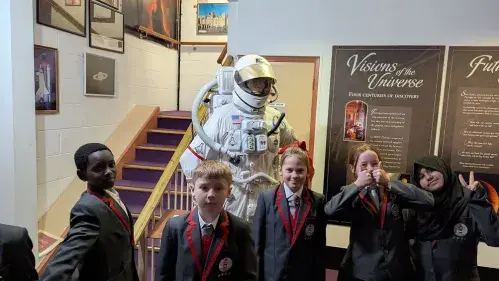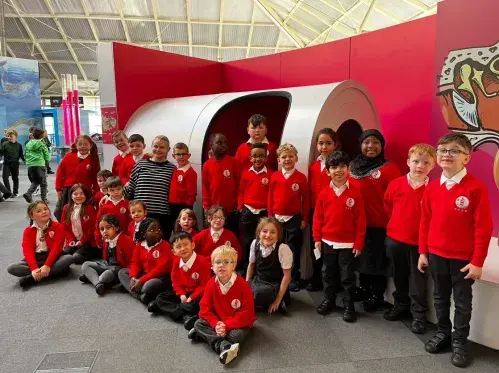Why do we learn science?
At Ark Ayrton, we believe a successful primary scientist:
- learns and develops the essential aspects of scientific knowledge, vocabulary, and conceptual understanding
- applies it through questioning, observation and conducting investigations or solving problems.
- gathers, records, and discusses data whether this be through simple sorting tasks or more in-depth investigations.
- applies and develops their understanding of science through different types of science enquiries that help them to answer scientific questions about the world around them
- has high expectations of themselves
- is exposed to the science in the environment around them, including local visits.
- can transfer skills and knowledge between the reading and writing curriculum
- is given the opportunity to see science in the ‘real world’ by learning about scientific careers and the people that work in them.
Our approach
Implementation
Medium term plans are produced with the ‘Key knowledge’ children need to learn ensuring clarity of coverage with a strong emphasis on progression of knowledge and skills. Investigative opportunities are planned to provide all children with first hand experiences to enhance their learning. Our science curriculum:
- starts from a learner’s existing understanding, which is gathered using pre-unit quizzes
- uses ‘Do Nows’ to recap prior knowledge and address misconceptions
- allows children to apply learning in a variety of ways both individually and collaboratively
- uses Exit Tickets to gather data on whether the WALT has been achieved
- The organisation of the science curriculum and timetabling enable learners opportunities for constant recapping of knowledge and skills with well-spaced reviews.
Impact
The impact of our curriculum is measured in terms of the extent to which children have developed new knowledge, understanding and skills and that they can use and recall these with fluency. This will be measured by:
- responses to pre-unit quizzes
- responses to questioning in the lesson
- application of learning in independent learning tasks - knowledge quiz assessment tasks
Enrichment
In addition to the science curriculum, enrichment is offered through:
- Celebrating British Science Week
- Visits and trips linked to the children’s learning
- Visitors
- Workshops
Curriculum Overview
Reception
Learn new vocabulary. Ask questions to find out more and to check what has been said to them. Articulate their ideas and thoughts in well-formed sentences. Describe events in some detail. Use talk to work out problems and organise thinking and activities. Explain how things work and why they might happen. Use new vocabulary in different contexts.
| Autumn | |
|---|---|
| Know and talk about the different factors that support their overall health and wellbeing: regular physical activity, healthy eating, toothbrushing, sensible amounts of ‘screen time’, having a good sleep routine, being a safe pedestrian. Manage their own basic hygiene and personal needs, including dressing, going to the toilet, and understanding the importance of healthy food choices |
| Spring | |
|---|---|
| Explore the natural world around them Describe what they can see, hear, and feel whilst outside Recognise some environments that are different to the one in which they live Understand the effect of changing seasons on the natural world around them Explore the natural world around them, making observations and drawing pictures of animals and plants. Know some similarities and differences between the natural world around them and contrasting environments, drawing on their experiences and what has been read in class |
| Summer | |
|---|---|
| Recognise some environments that are different to the one in which they live Know some similarities and differences between the natural world around them and contrasting environments, drawing on their experiences and what has been read in class. |
Year 1
Asking simple questions and recognising that they can be answered in different ways. Observing closely, using simple equipment. Performing simple tests. Identifying and classifying. Using their observations and ideas to suggest answers to questions. Gathering and recording data to help in answering questions.
| Autumn | |
|---|---|
|
Everyday Seasonal Changes (Autumn/Winter) |
| Spring | |
|---|---|
|
Animals, including Humans Seasonal Changes (Spring/Summer) |
| Summer | |
|---|---|
| Plants identify and name a variety of common wild and garden plants, including deciduous and evergreen trees identify and describe the basic structure of a variety of common flowering plants, including trees. |
Year 2
Asking simple questions and recognising that they can be answered in different ways. Observing closely, using simple equipment. Performing simple tests. Identifying and classifying. Using their observations and ideas to suggest answers to questions. Gathering and recording data to help in answering questions.
| Autumn | |
|---|---|
|
Uses of Everyday Materials |
| Spring | |
|---|---|
|
Animals, including Humans Plants |
| Summer | |
|---|---|
| Living Things and Their Habitats explore and compare the differences between things that are living, dead, and things that have never been alive identify that most living things live in habitats to which they are suited and describe how different habitats provide for the basic needs of different kinds of animals and plants, and how they depend on each other identify and name a variety of plants and animals in their habitats, including microhabitats describe how animals obtain their food from plants and other animals, using the idea of a simple food chain, and identify and name different sources of food. |
Year 3
Asking relevant questions and using different types of scientific enquiries to answer them. Setting up simple practical enquiries, comparative, and fair tests. Making systematic and careful observations and, where appropriate, taking accurate. Measurements using standard units, using a range of equipment, including thermometers and data loggers gathering, recording, classifying, and presenting data in a variety of ways to help in answering questions. Recording findings using simple scientific language, drawings, labelled diagrams, keys, bar charts, and tables. Reporting on findings from enquiries, including oral and written explanations, displays or presentations of results and conclusions. Using results to draw simple conclusions, make predictions for new values, suggest improvements, and raise further questions identifying differences, similarities or changes related to simple scientific ideas and processes. Using straightforward scientific evidence to answer questions or to support their findings.
| Autumn | |
|---|---|
|
Rocks Light |
| Spring | |
|---|---|
|
Forces and Magnets Animals, including Humans |
| Summer | |
|---|---|
| Plants identify and describe the functions of different parts of flowering plants: roots, stem/trunk, leaves and flowers explore the requirements of plants for life and growth (air, light, water, nutrients from soil, and room to grow) and how they vary from plant to plant investigate the way in which water is transported within plants explore the part that flowers play in the life cycle of flowering plants, including pollination, seed formation and seed dispersal |
Year 4
Asking relevant questions and using different types of scientific enquiries to answer them. Setting up simple practical enquiries, comparative, and fair tests. Making systematic and careful observations and, where appropriate, taking accurate. Measurements using standard units, using a range of equipment, including thermometers and data loggers gathering, recording, classifying, and presenting data in a variety of ways to help in answering questions. Recording findings using simple scientific language, drawings, labelled diagrams, keys, bar charts, and tables. Reporting on findings from enquiries, including oral and written explanations, displays or presentations of results and conclusions. Using results to draw simple conclusions, make predictions for new values, suggest improvements, and raise further questions identifying differences, similarities or changes related to simple scientific ideas and processes. Using straightforward scientific evidence to answer questions or to support their findings.
| Autumn | |
|---|---|
|
States of Matter Animals, including Humans |
| Spring | |
|---|---|
|
Sound Electricity |
| Summer | |
|---|---|
| Living Things and their Habitats recognise that living things can be grouped in a variety of ways explore and use classification keys to help group, identify and name a variety of living things in their local and wider environment recognise that environments can change and that this can sometimes pose dangers to living things. |
Year 5
Planning different types of scientific enquiries to answer questions, including recognising, and controlling variables where necessary. Taking measurements, using a range of scientific equipment, with increasing accuracy and precision, taking repeat readings when appropriate. Recording data and results of increasing complexity using scientific diagrams and labels, classification keys, tables, scatter graphs, bar, and line graphs. Using test results to make predictions to set up further comparative and fair tests. Reporting and presenting findings from enquiries, including conclusions, causal relationships, and explanations of and degree of trust in results, in oral and written forms such as displays and other presentations. Identifying scientific evidence that has been used to support or refute ideas or arguments.
| Autumn | |
|---|---|
|
Properties and Changes of Materials Earth and Space |
| Spring | |
|---|---|
|
Forces Living Things and their Habitats |
| Summer | |
|---|---|
| Animals, including Humans describe the changes as humans develop to old age. |
Year 6
Planning different types of scientific enquiries to answer questions, including recognising, and controlling variables where necessary. Taking measurements, using a range of scientific equipment, with increasing accuracy and precision, taking repeat readings when appropriate. Recording data and results of increasing complexity using scientific diagrams and labels, classification keys, tables, scatter graphs, bar, and line graphs. Using test results to make predictions to set up further comparative and fair tests. Reporting and presenting findings from enquiries, including conclusions, causal relationships, and explanations of and degree of trust in results, in oral and written forms such as displays and other presentations. Identifying scientific evidence that has been used to support or refute ideas or arguments.
| Autumn | |
|---|---|
|
Light Electricity |
| Spring | |
|---|---|
|
Evolution and Inheritance Animals, including Humans |
| Summer | |
|---|---|
|
Living Things and their Habitats |


